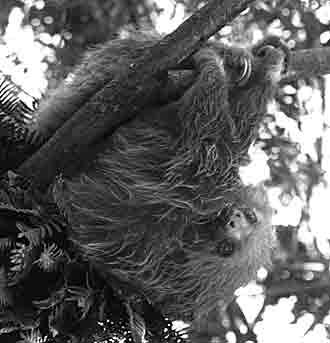Hanging upside-down from the branches of trees in
Costa Rica's lush rain forests, sleep the two and three-toed sloths.
The Spanish word for sloth is perezoso, meaning “lazy”, and
the sloths, who sleep around eighteen hours a day, live up to their reputation.
Because of their “lazy” or slow-moving nature, sloths live
high in the forest canopy, which camouflages them from predators. They
spend most of their time in the trees, descending only to take care of
bodily functions which, because of their slow digestive system, they
need do only once a week. Upon descending from the tree, the sloth digs
a little hole and buries its wastes. This fertilizes the tree the sloth
has been feeding upon. Insects, which live on the sloth, lay their eggs
in its droppings. Each sloth acts like a miniature ecosystem in which
hundreds of insects survive on its back, eating molds, fungus and insects.
By adulthood sloths are about as big as a medium sized dog. Their permanent
smiling expression gives them almost human-like characteristics. These
fascinating creatures can live up to thirty years. They begin reproducing
at about age three and bear one baby a year. Unfortunately, if a baby
falls from the tree, the mother will let it die, rather than climb down
and expose herself to predators attracted by the baby's cries.
Costa Rica is a wonderful place to observe and photograph sloths, because
of the abundance of cecropia trees, which are the sloth's favorite food.
The leaves of these trees are spread out enough to make “sloth-watching” easy,
and “sloth-watchers”. . . yawn . . tend to be very. . . yawn
. . . relaxed individuals.
Click Here for information on our Costa Rica Tours.


 By
Lori Klein
By
Lori Klein
